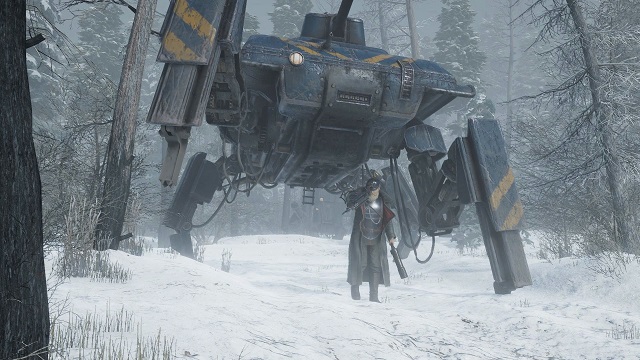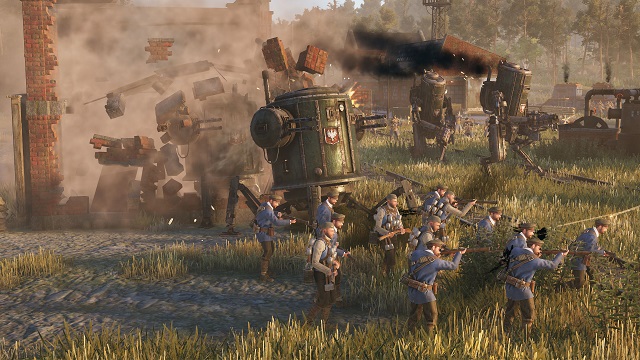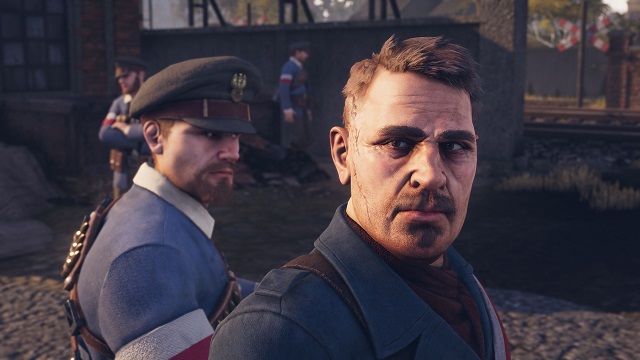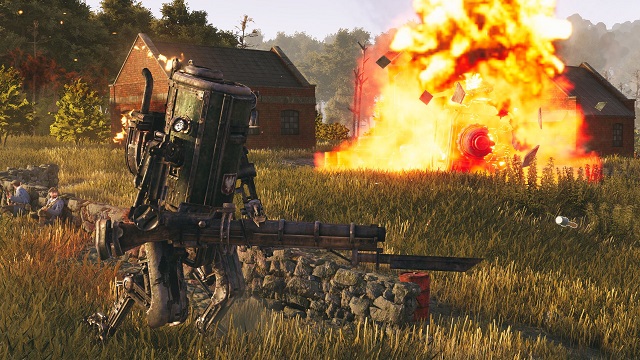Iron Harvest should immediately catch your eye. At first glance, you might mistake it for any other historical skirmish RTS. Groups of infantry take cover, tossing grenades and laying down suppressing fire to rout their foes. However, things start to change when the big guns show up. It isn’t tanks rolling over the horizon, but giant mechs lumbering across the land.
This is the “World of 1920+,” a post-WWI alternate history that sees the world’s remaining national superpowers creating massive diesel mechs in a steampunk arms race.
These mechs are a sight to behold. They aren’t slick and graceful alien beasts. They are big, loud, and clunky. Many of them look like they’re made from repurposed farm equipment, and they spit just as much black smoke into the air as they do ordinance onto the battlefield.
These mechs are the heart and soul of Iron Harvest; they help turn an otherwise solid but unremarkable game into much more of a spectacle. If you enjoy RTS games like Company of Heroes but want to go a little more fantastical with your approach, Iron Harvest is a perfect fit.
Iron Harvest Review: Diesel Destruction

Iron Harvest is more focused (right now, at least) on its single-player aspect. There are some multiplayer options and some indications those might get beefed up in the future, but the cinematic campaign is where you’ll get the most bang for your buck at launch.
Each of the three major nations — Polania, Rusviet, and Saxony — have their own story to tell, with different heroes and environments to blast your way through. There are several different types of missions, with plenty of evolving stories and optional objectives.
Gameplay boils down to pretty expected fare, though. There are several control points scattered across the map, and the more you control, the quicker you generate resources. Base building is not overly complicated, and the three nations all follow nearly identical tech trees and early unit requirements. Iron Harvest is mostly concerned with tactics and combat, as opposed to winning through supreme economy management.
When it comes to infantry, you’re encouraged to use cover and a variety of tactics as you work your way up the tech tree towards your bigger guns. Basic infantry is strong at setting up bottlenecks and laying down impressive amounts of low-level firepower. You can eventually build into stronger infantry units, like grenadiers and engineers, who use explosives, repair units, lay down traps, and specialize in a variety of other techniques.
You’ve also got a few hero units at your command. The first campaign as Polania sees you controlling a teenage sniper with a pet bear. Catching infantry out in the open with her is a fairly easy win.
Eventually, the mechs are going to come out and play. They start relatively small: sort of 1920s versions of exosuits. Even the most basic mechs are mighty, but Iron Harvest is a game that rewards you for planning your tactics.
A clever group of grenadiers can lay waste to superior firepower if you position them correctly and plan your techniques correctly. The economic swing of low-level units destroying much more expensive ones (and then stealing the resources from their charred out husks) is satisfying and a great way to turn the tide.
The most powerful mechs tend to throw the balance off a bit, but that’s kind of to be expected. A massive, AT-AT-esque hulk wandering across the European countryside is going to make quick work of a bunch of dudes with single-shot rifles, no matter how you slice it. You’ve just got to make sure you’re ready with your supermechs by the time the other side’s come online.
Symphony of Destruction

It helps that everything in Iron Harvest looks and sounds so good. Character models can get a bit dodgy when you zoom in too close, but their icons stand out when you are in your big picture view, and it isn’t hard to figure out the relative strength of forces once you’ve played for a few hours.
The size and scale of things are nice: infantry units look like proper little bugs when the biggest mechs start rolling off the production line. And the mechs themselves look great. They’re properly big and beefy, with wobbly legs and all sorts of nice touches that make them feel of the time, despite coming from such a strange steampunk world.
The graphics are solid, but the sound design is what helps the battles of Iron Harvest come to life. When a massive engagement starts, the constant chattering of guns, booming explosions, and shouts of soldiers as they move from position to position all help bring urgency to things.
Soon, that urgency comes to a head when the clanking mechs start stomping around, literally crushing buildings as they slowly make their way to the fight. Soon, their cannons are all you can hear, and a battlefield full of artillery craters is usually all that’s left when the shooting starts.
Well made RTS games do a great job of making you feel satisfied after a particularly harrowing win. Even with superior firepower, victory is never assured in Iron Harvest. You still need to be tactical in your approach and keep an eye out for opportunities. After all, even victory can be costly, and the difference between keeping one of your most potent mechs just barely alive and losing it to the scrap heap can be significant in the outcome of a given scenario.
Big Shoes to Fill

Not everything is perfect in Iron Harvest. The lore and personalities of the different factions are distinct, but there isn’t much difference in the playstyle of faction. Maintaining balance when having factions that play differently from one another is a significant challenge. Still, it would be nice if it were more than just, “Well, Polania has a mech that’s a bit different…”
Cover is fiddly, and it isn’t very intuitive what will work and how well it will work. Part of this comes from experience. You’ll start to identify things on sight a little better as you put the time in. Iron Harvest can be punishing if the tactics you think you’re employing don’t work.
Sending a group of infantry to take cover by a ridge, only to have them get torn apart by machine guns because they can’t or won’t take cover can set you back immensely, and can often call for a quick restart.
Finally, a few things that will probably be tweaked over time but still stand out as issues on launch come in the form of balance and polish.
For the most part, things are balanced during small scale skirmishes, but the way missions can change on the fly can sometimes call for a total wipe. Perhaps you built your force to handle a specific type of enemy, but suddenly, something you’ve never seen before swoops out and decimates you. Sometimes, the big gun just big guns you.
In short, it can be frustrating to restart due to some ridiculous onslaught of enemies after you’ve been tactical and creative in tackling the problem in front of you for so long.
Some polish issues could use some work, too: some of the voice acting and lines come across as cliched and stilted, but it isn’t a massive issue.
The Bottom Line — Iron Harvest Review

Pros:
- Draws you in with unique world and mech design
- Excellent sound quality
- Tactics matter; overwhelming odds can be taken down by thinking ahead
- Satisfying
Cons:
- Some balance issues
- Three factions don’t have distinct playstyles
- Certain mechanics don’t seem to work consistently
- Not many multiplayer options
If you’re looking for a strong, single-player RTS with a unique world to explore, Iron Harvest is a perfect option. The world is well-realized, and the mechs offer a sense of style that sometimes get lost in historical strategy games. A train car on legs firing huge artillery shells is a little more memorable than a different-colored tank.
Some issues could stand to be ironed out, but nothing that is a significant detriment. The cover system and focus on a tactical approach make ever decision seem significant, and winning a battle in Iron Harvest is extremely rewarding.
If you crave spectacle in your strategy games, do yourself a favor and lead Polania to victory!
[Note: Deep Silver provided the copy of Iron Harvest used for this review.]







Published: Aug 31, 2020 10:51 am